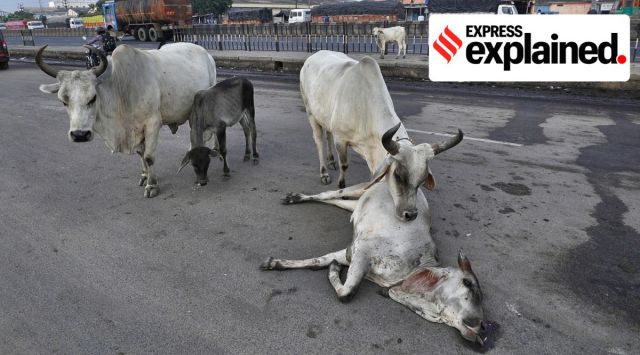- India
- International
How ICAR’s new vaccine against Lumpy Skin Disease, the viral infection killing India’s cattle, will work
Lumpy Skin Disease vaccine: Lumpi-ProVacInd, which could be commercially launched in a few months, is a homologous, live attenuated vaccine specifically targeted to protect cattle against the LSD virus.
 A carcass of a cow who succumbed to Lumpy Skin Disease seen in Gujarat. (Express Photo: Nirmal Harindran)
A carcass of a cow who succumbed to Lumpy Skin Disease seen in Gujarat. (Express Photo: Nirmal Harindran)The Indian Council of Agricultural Research (ICAR) is aiming to commercially launch in “four-five months” its indigenously-developed vaccine against the Lumpy Skin Disease (LSD) virus that has killed around 50,000 heads of cattle in several states since April.
Bhupendra Nath Tripathi, Deputy Director-General (Animal Sciences) of ICAR, said that Agrinnovate India, the commercialisation arm for products and technologies developed by ICAR institutes, had issued an expression of interest document for the vaccine, ‘Lumpi-ProVacInd’, last month, and that three companies had shown interest.
What is Lumpi-ProVacInd, and how does it work?
The vaccine, which has been jointly developed by ICAR’s National Research Centre on Equines (NRCE) at Hisar, Haryana and the Indian Veterinary Research Institute (IVRI) at Izatnagar, UP, is a live attenuated vaccine, similar to those used against tuberculosis, measles, mumps and rubella.
“It is also homologous, providing 100 per cent protection against LSD in cattle. Currently, we are only administering goat pox and sheep pox virus vaccines. These are heterologous vaccines offering only cross-protection (up to 60-70 per cent) for cattle against LSD, by virtue of all the three viruses belonging to the same capripoxvirus genus,” Tripathi explained to The Indian Express.
Inactivated virus vaccines, such as Bharat Biotech’s Covaxin that is being used to inoculate people against Covid-19, are less effective, with just 5-6 months efficacy against capripox viruses. Hence, the choice of a live attenuated vaccine for LSD.

How was the Lumpy Skin Disease vaccine developed?
Naveen Kumar, veterinary virologist and principal scientist at NRCE, said that the institute had collected skin nodule samples from LSD-infected cows near Ranchi in December 2019. The virus was isolated at the Hisar-based institute by early-January 2020. This was a period when cases of the disease were coming in from Odisha and eastern states. “These weren’t leading to any mortality. But being a virus totally new to India, we decided to work on it,” he said.
The next step was to propagate the isolated virus in African green monkey kidney (Vero) cells used in cultures. The culturing was done over 50 generations (“passages”) and took about 17 months. As the virus mutated after repeated passages, its virulence or disease-causing ability weakened. The pathogenicity loss started from around the 30th passage, although the mutated virus could induce the necessary immune response from its host.
“We did sequencing of the virus genome at the start and the 10th, 30th and 50th passages. The attenuated live virus was identified as a vaccine candidate after the 50th passage and tested on our laboratory mice and rabbits,” Kumar said.
In April this year, experimental trials of the vaccine candidate on the natural host (cattle) was undertaken at IVRI. These included 10 male calves that were administered the vaccine and five “control” animals that weren’t. After a month, both sets of calves were injected with the virulent virus. The control calves showed most of the LSD symptoms, whereas the vaccinated animals had developed full immunity.
Since July, field trials have also taken place, starting with 140-odd cattle (lactating and pregnant cows as well as calves, heifers and bulls) at a gaushala at Banswara in Rajasthan. The vaccine has also been administered to animals in 35 other gaushalas and dairy farms in Udaipur, Alwar and Jodhpur, besides Hisar and Hansi (Haryana) and Mathura (UP).
“We have not seen the disease in any of these animals, even while it has spread everywhere around them,” said Kumar.
So what exactly is the Lumpy Skin Disease virus and how prevalent is it?
LSD is caused by the lumpy skin disease virus (LSDV), which is a virus of the capripoxvirus genus in the poxviridae family. Sheeppox virus and goatpox virus are the other members of the genus capripoxvirus. The LSDV mainly infects cattle: cow and its progeny, and the Asian water buffalo.
According to a 2021 report of the United Nations Food and Agriculture Organisation (FAO), LSD outbreaks occur as epidemics several years apart. There is no known specific reservoir of the virus, and it is also not known where and how the virus survives between epidemics, the FAO report said.
The FAO report said that after being restricted for long to sub-Saharan Africa, the virus has spread to the Middle East and Turkey over the past decade. From 2015 onward, it has infected cattle in southeastern and Eastern Europe and in Russia.
LSD entered India, Bangladesh and China in July 2019. Since then, outbreaks of the disease have been reported from 20 Indian states and UTs, including Assam, Andhra Pradesh, Bihar, Chhattisgarh, Goa, Gujarat, Haryana, Jharkhand, Karnataka, Kerala, Maharashtra, Madhya Pradesh, Manipur, Odisha, Tamil Nadu, Telangana, Uttar Pradesh, and West Bengal.
How does LSD spread, and what are the symptoms of the disease?
LSDV spreads through blood-sucking vectors like ticks, mites, and mosquitoes, and also through contaminated water, fodder, and feed. Mosquito and housefly infestations reach their peak during the monsoon, and veterinary scientists and government officers blamed the very wet July for the rapid spread of the infection this year especially in Gujarat, where the outbreak started.
Scientists have been advising that infected animals be isolated; however, the large numbers of stray cattle makes this task difficult, and has possibly been contributing to the rapid spread of the disease.
LSDV attacks the circulatory system of an animal and causes vasculitis or inflammation of blood vessels and lesions in organs like liver, lungs, spleen, lymph nodes etc, Prof R M Patel, head of the department of medicine at the College of Veterinary Science and Animal Husbandry (CVSAS), Dantiwada, said.
The epidermis, the outer surface of the skin, gets separated from the dermis or inner layer, leading to the formation of lumps or nodules on an animal’s body. Fever, increased mucus secretion, and loss of appetite are among the other symptoms.
Autopsies carried out by Prof Patel’s team on eight carcasses in Kutch and Banaskantha found that the virus had caused necrotising vasculitis, or the death of tissues, and fibrosis in various organs of the infected cattle, leading to their death.
Also, the nodules may burst due to outer pressure or friction as the skin covering such nodules is very thin. The open wounds make the animals susceptible to secondary bacterial and protozoal infections, and maggot infestations can prove fatal.
And how bad is the current outbreak of Lumpy Skin Disease in India?
There were small outbreaks in Gujarat’s Kheda and Anand in 2020 and 2021, which the state animal husbandry department controlled by treating the infected cattle and giving goat pox vaccine to healthy animals in peripheral areas. But this year has been very different.
Since the first case was reported from Kaiyari, a village on the Indo-Pak border in Lakhpat taluka of Kutch, LSD has swept through the state, infecting cows of all breeds, and spread to at least 11 other states and Union Territories. Buffaloes have been largely safe.
According to official data, LSD has infected about 11.21 lakh cattle and caused 49,628 deaths across India as on August 31. The virus has been reported in Rajasthan (31 districts), Gujarat (26), Punjab (24), Haryana (22), Uttar Pradesh (21), Jammu & Kashmir (18), Himachal Pradesh (9), Madhya Pradesh (5), Uttarakhand (4), Maharashtra (3), Goa (1), and Andaman & Nicobar Islands (1).
Government officials said the actual numbers of both infections and deaths could be much higher — many dairy farmers and cattle herders may not be reporting cases, or they could be consulting private veterinarians.
More Explained
EXPRESS OPINION
Apr 26: Latest News
- 01
- 02
- 03
- 04
- 05









































